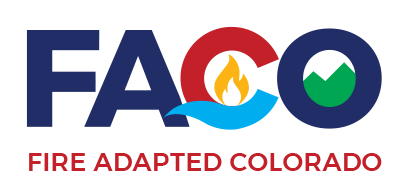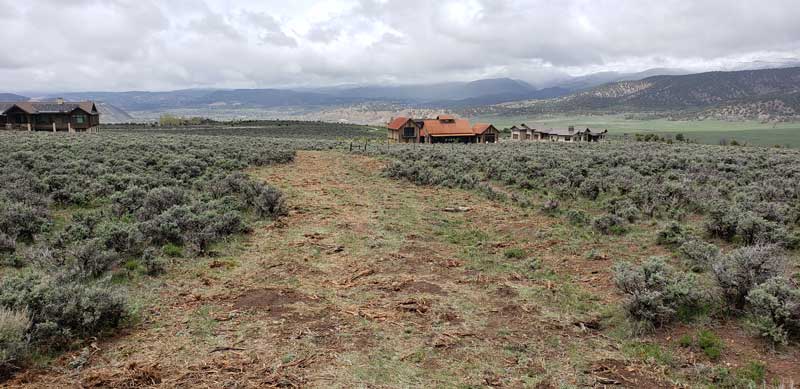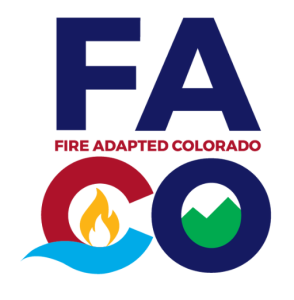Fire Adapted Colorado’s Opportunity Fund:
Creating a big impact with a little funding
A little support has gone a long way toward community wildfire resilience around the state. In 2017, Fire Adapted Colorado (FACO) launched an Opportunity Fund matching mini-grant program to support members’ projects, capacity, and unique local needs with funding through the National Fire Adapted Communities Learning Network. Last year, this supported six organizations. In the first half of 2019 another five organizations stretched a $9,500 investment and an additional three benefited from technical support. Let us keep up the great work.
FACO members have no shortage of great ideas and unmet needs to propel community wildfire resilience forward in their communities. The Fire Adapted Colorado board members reviewing proposals would all have loved to fully fund every proposal that was submitted. Eight proposals requesting $17,688 were received and the committee had to work within a $10,000 budget. To those that had to be turned down or decreased, FACO worked to provide other reference materials, resources, funding ideas and technical assistance.
Awarded Projects
Boulder County Wildfire Partners:
A Professional Wildfire Mitigation Photo Library
As wildfire mitigation practitioners, we know the importance of embers when it comes to home destruction. We have watched the Insurance Institute for Business and Home Safety (IIBHS) videos and read their research. We have taken NFPA’s Assessing Structure Ignition Potential from Wildfire training course. We have participated in post-fire assessments and seen homes that have survived wildfires because they were properly retrofitted next to homes that were destroyed because they were not. Intellectually, we support our profession’s long-standing advice to homeowners—Start with the Home! However, in practice, managing vegetation—more specifically cutting trees—makes up the lion’s share of our work. In addition, a large number of homes where good defensible space has been established are not retrofitted to reduce their vulnerability to ember ignition. In these cases, a great deal of time and money has been spent, but expectations of reduce wildfire risk are creating false expectations.
The FACO Board and Selection Panel were very excited when a proposal to help FACO members at large came in. To help advance home hardening efforts, Wildfire Partners has put together a photo library of common home retrofits with support of an Opportunity Fund Grant. Wildfire Partners’ contractor, Natural Focus Digital, has also produced videos and other mitigation-related photos as part of this project. The photo library (350+) and videos are available to download free of charge from google drive here. FACO members are encouraged to use these photos and videos to augment existing photo collections in literature, websites and presentations to better promote and accomplish home hardening.
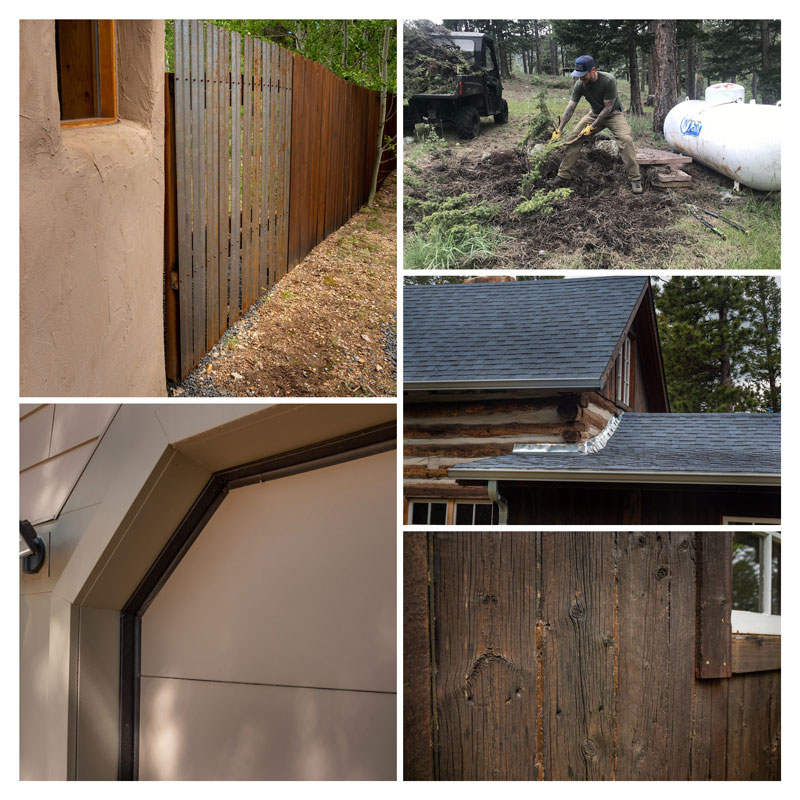
Above are examples from the Boulder County Wildfire Partners and FACO home retrofit photo library. Clockwise from top left: a non-combustible fence panel inserted between home and wood fence; homeowner removes brush and prepares to lay stone around the propane tank; flashing was added along a roof/wall edge; cracks and gaps in wooden siding were calked to prevent ember intrusion; Weather stripping was replaced around a garage door.
Dolores Watershed Resilient Forest Collaborative:
Cooperative Burning, Private Land
With funding from FACO, The Nature Conservancy, and the San Juan National Forest, the Dolores Watershed Resilient Forest (DWRF) Collaborative burned approximately 50 piles remaining from a 23-acre fuels reduction project at The Nature Center at Butler Corner. The San Juan National Forest (SJNF) plans to conduct prescribed burning on the adjacent public land in coming years and this private land pile burn helps to facilitate a larger restoration landscape.
The Nature Center at Butler Corner hosts experiential education activities for children and has miles of forest trails for youth and adults to learn about nature. This project helped reduce wildfire risk at the nature center and it will illustrate the structure and benefits of a healthy ponderosa forest for years to come. The DWRF Collaborative Coordinator, Danny Margoles, brought together individuals from the US Forest Service, Wildfire Adapted Partnership, a private forestry contractor who served as the burn boss, a wildfire mitigation company, and himself to plan, permit, conduct, monitor, report, and build experience through this burn. Danny used this pile burning to demonstrate successful collaboration resulting in on-the-ground wildfire risk reduction. He also took the opportunity to publish the first Instagram post for the collaborative showing the pile burning and highlighting upcoming prescribed burns planned on nearby public lands. Through this project, Danny learned the importance of conducting prescribed burns at any opportunity when the plan parameters are met and got his first hands-on experience in a coordination role planning for a burn operation.
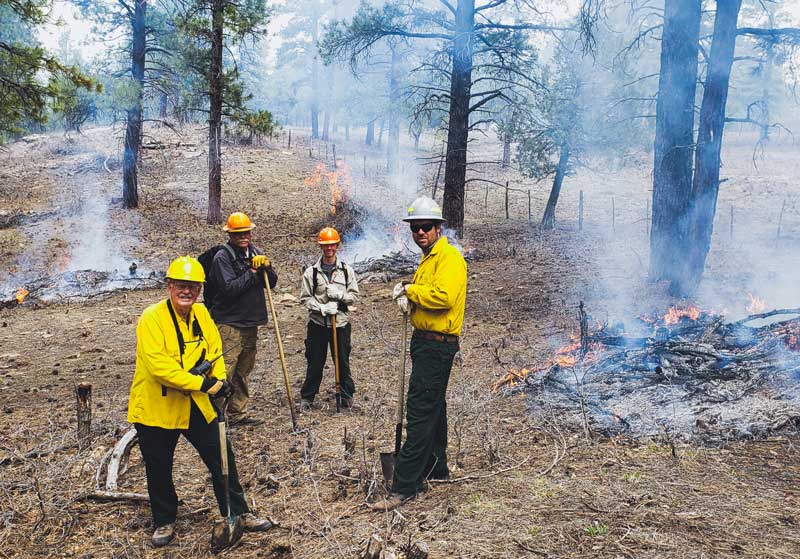
A private forester, mitigation contractors, and a volunteer whose day job is with the USFS stopped together briefly when burning piles at the Nature Center at Butler Corner.
Greater Eagle Fire Protection District:
Highlands Ranch Masticated Fuel Break
Hugh Fairfield-Smith, who leads the department’s wildland division, and Chief Doug Cupp have a vision for ‘Fire Adapted Eagle’. Their vision includes fuel breaks in strategic locations around the highly valued homes and resources that they are sworn to protect. With support from Fire Adapted Colorado board members Paul Cada and Eric Lovgren who live in communities nearby, Hugh was able to refine the scope of his department’s first hydro-mowing project, invest in community outreach, and develop two miles of new fuel break tying together existing natural and manmade fuel breaks across the overgrown sage brush slopes below Eagle Ranch.
West Region Wildfire Council:
The Brass Tacks: Wildfire Mitigation Program Needs
For Colorado’s non-profit organizations, the brass tacks can be the most challenging needs to fund. When West Region Wildfire Council’s Director, Lilia Falk, learned that she would need an OSHA approved fire-proof paint cabinet to house their forestry paint for designing and marking wildfire mitigation projects, she wondered where the funding could come from. With staff using their own vehicles, field clothes, and a six year old laptop that their office work depended upon, Lilia reached out to Fire Adapted Colorado to request the priority equipment that her staff needed to support over 250 assessments and associated mitigation projects each summer. Staff is already appreciating their
- OSHA fire proof paint cabinet,
- A Dell laptop with Techsoup sponsored Microsoft Office & Adobe Software,
- Paint and field supply totes to contain and organize field supplies,
- Car magnets to identify private vehicles when staff is on WRWC business, and
- New forestry field vests and compasses for Wildfire Mitigation Specialists’ daily use.

West Region Wildfire Council was able to replace worn out field vests among other essentials with an Opportunity Fund grant.
Wildfire Adapted Partnership:
Education and Outreach Materials Feature New Name
The new Wildfire Adapted Partnership banner adorned Main Street in Durango in May.
This organization became an independent non-profit after fifteen years of operating under a fiscal sponsor and changed their name while continuing to offer the same great programs and services. Ashley Downing, Wildfire Adapted Partnership’s Executive Director, has made every effort to maintain consistency and get the word out that while their name has changed their core programs and mission to protect lives and property from wildfire has not. Wildfire Adapted Partnership is still the go-to organization for supporting community wildfire adaptation in southwest Colorado. FACO’s Opportunity Fund grant provided the base capital to procure branded materials with their new name.
 The new Wildfire Adapted Partnership banner adorned Durango’s Main Street in May.
The new Wildfire Adapted Partnership banner adorned Durango’s Main Street in May.
Technical Support:
Fire Adapted Colorado’s selection panel worked to support the needs of all of the Opportunity Fund applicants. In addition to making awards, board members and FACO’s Director reached out to applicants to support both funded and unfunded projects.
Fire Adapted Bailey was awarded an Opportunity Fund grant for a rapid risk assessment project, but it was not funded due to time limitations. The Fire Adapted Bailey team is still working to finalize the details of their project and timing with their Fire District partners and the WiRē Team to launch this project in Burland Ranchettes, one of the area’s many Firewise USA® communities, after their initial efforts to launch in a different neighborhood this spring were met with many hurdles. FACO provided some connections and ideas and allowed for adjustments to the project that would still meet the intent of the project. FAB is encouraged to bring this project back for consideration in the future.
Eagle River Fire Protection District’s request for new and replacement fire danger rating signs was not funded, but FACO provided other funding suggestions and an affordable option for purchasing new signs.
FACO was unable to meet Central Colorado Conservancy’s request for financial support to develop a ‘next generation’ Community Wildfire Protection Plan, but we collected and shared CWPP and fire and post-fire modeling resources and a connection to the Community Planning Center for Wildfire to help integrate their plans and policies. This project is well underway with support of Chaffee County’s conservation mill levy and the Colorado Department of Local Affairs.
Future of the Opportunity Fund:
In light of so many great projects and ideas, it remains a priority of the Fire Adapted Colorado Board to secure new funding sources to continue offering Opportunity Fund awards. Securing new funds will allow FACO to provide flexible funding for more successful projects and capacity support for new organizations as well as long-standing efforts striving to meet local FAC needs. To learn more about the Opportunity Fund or donate to the cause, contact Executive Director Rebecca Samulski at 970-739-7899 or fireadaptedco@gmail.com.
